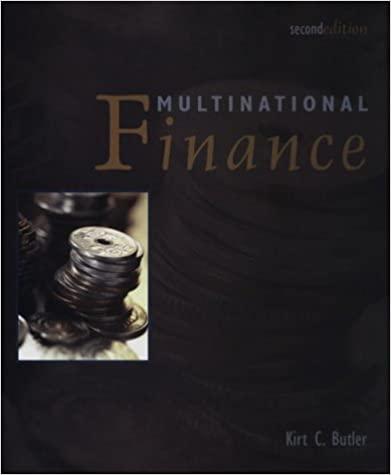Question
1) From the following income statement, calculate the: Degree of Financial Leverage and describe in one sentence or less what the answer indicates Degree of
1) From the following income statement, calculate the:
Degree of Financial Leverage and describe in one sentence or less what the answer indicates
Degree of Operating Leverage and describe in one sentence or less what the answer indicates
Degree of Combined Leverage and describe in one sentence or less what the answer indicates
Income Statement
For year ended 12/31/15
Sales $575,000
Total Variable Costs 260,000
Fixed Costs 94,000
EBIT 221,000
Interest 19,500
EBT 201,500
Taxes (35%) 70,525
Net Income $ 130,975
Shares Outstanding 20,000
EPS $6.55
2) Heister Corporation produces class rings to sell to college students. These rings sell for $75 each and cost $30 each to produce. Heister has FC of $45,000.
Calculate Heisters break-even point.
How much profit (loss) will Heister have if it sells 800 rings? 6,000 rings?
Heisters CEO expects an annual profit of $200,000. How many rings must be sold to attain this profit? (round up to the nearest whole number)
3) You purchase an IBM bond with a par value of $1,000 that carries a semiannual coupon rate of 4%, has a 5-year maturity and sells at par.
What will be the bonds price one year later if the YTM has decreased by 1%
If you sell the bone at the price (a) above, what was is your HPR (Holding Period Return)? Round your answer to two (2) decimal places.
4 ) The Nickelodeon Manufacturing Corp. has a series of $1,000 par value bonds outstanding. Each bond pays interest (coupon payment) semi-annually and carries an annual coupon rate of 6%. Some bonds have a maturity date of 4 years and some have a maturity date of 10 years. If the YTM is 10%, what is the current price of: Round your answers to 2 decimal points:
The bonds with 4 year maturity
The bonds with 10 year maturity
Are the bonds selling at a discount, at par, or at a premium? Briefly explain.
Which of the bonds has a higher selling price under the current market conditions? Briefly explain.
5) What is the value after 3 years of a $500 deposit earning an APR or 10% compounded semi-annually? 8 points (3/5)
N = 6
I = 10
PV = -500
PMT =0
FV
P/Y = 2
Allocate the interest between ORIGINAL DEPOSIT, SIMPLE INTEREST, COMPOUND INTEREST
| Original Deposit |
|
| Simple Interest |
|
| Compound Interest |
|
|
|
6) An issue of common stock is selling for $57.20 per share. The year-end dividend is expected to be $2.32, assuming a constant growth rate of 4%, what is the required rate of return?
7) An issue of preferred stock is paying an annual dividend of $1.50 per share. The growth rate for the firms common stock is 5%. What is the preferred stock price if the required rate is 7%?
8) In the Third Column, put the number of the term that best answers the definition.
| CORRECT NUMBER | ||
| Fixed Costs | Interest or return that is accumulated every six months |
|
| Financial Leverage | The result of subtracting all variable expenses from revenues. It indicates the amount available from sales to cover the fixed expenses and then profit |
|
| Contribution margin | The percentage rate at which future sums or annuities are brought back to their present value |
|
| Variable Costs | Based on the concept that a dollar you have today is worth more than the promise or expectation that you will receive a dollar in the future |
|
| Combined Leverage | A series of consecutive equal cash flows that occur at the end of a period for a fixed number of periods |
|
| Break-even Analysis | Costs that change directly and proportionately with a change in sales volume |
|
| Present Value | Interest payable on principle |
|
| Discount Rate | The value of an asset is equal to the present discounted value of the cash flows that the asset is expected to generate |
|
| Annuity | The use of fixed charge obligations (borrowing) with the intent of magnifying the potential returns to the firms investors |
|
| Future Value of an Annuity | A numerical and graphical technique used to determine at what point the firm will equate costs and revenues |
|
| Future Value | Costs that remain relatively constant regardless of the volume of sales |
|
| Semi-annual compounding | The amount of money that an investment with a fixed compounded interest rate will grow to by some future date |
|
| Time Value of Money (TVM) | A measure of the amount of debt used in the capital structure of a firm |
|
| Leverage | Interest added to the principal of a deposit or loan so that the added interest also earns interest |
|
| Fundamental Principle of Finance | A series of constant equal cash flows into a fund that increase in size up to a future point in time |
|
| Compound Interest | The total impact of financial and operating leverage |
|
| Simple Interest | The discounted value of a future sum as of todays values |
|
Step by Step Solution
There are 3 Steps involved in it
Step: 1

Get Instant Access to Expert-Tailored Solutions
See step-by-step solutions with expert insights and AI powered tools for academic success
Step: 2

Step: 3

Ace Your Homework with AI
Get the answers you need in no time with our AI-driven, step-by-step assistance
Get Started


